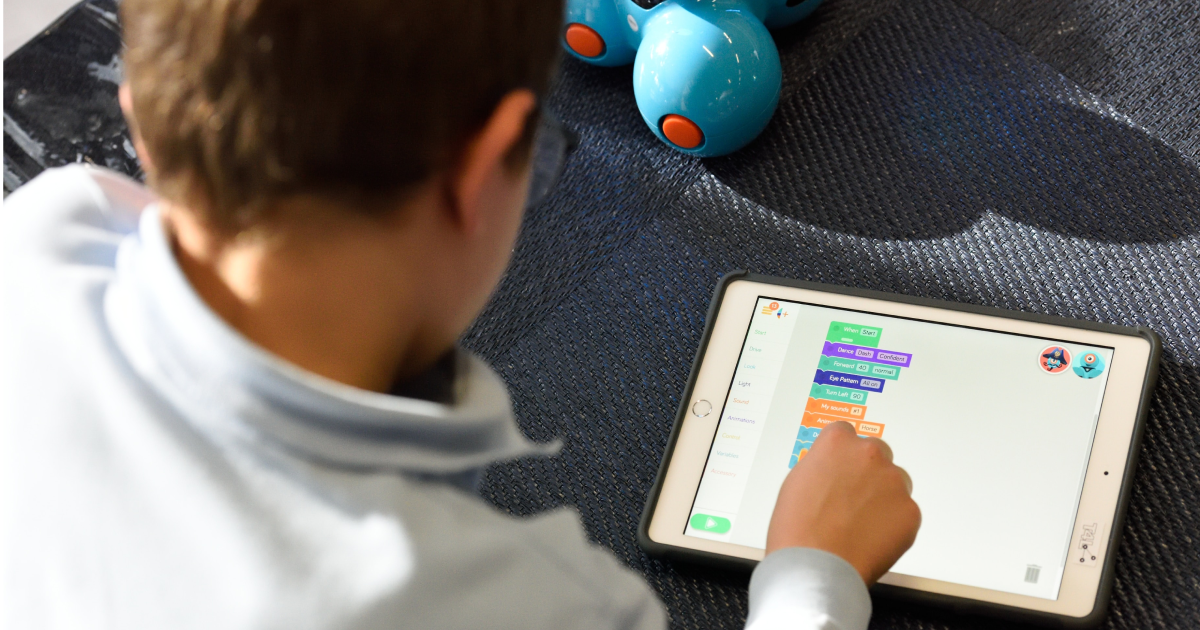
Top 10 digital transformation trends in education
Aug 25
11 min read
As we look to the future, it's clear that the job landscape, in 10 years time, will be vastly different from what we know today. While demand for some roles may start to dwindle, new opportunities will emerge, offering a fresh pool of occupations for children to explore.
In this ever-changing world, it's important that our education system adapts and evolves to keep pace. Fortunately, rapid advances in technology are already transforming education in new and exciting ways.
In this article, we'll be discussing the top 10 digital transformation trends in education. From artificial intelligence to gamification, virtual reality to personalized learning, these digital trends are shaping the future of schooling.
What is digital transformation in education?
Digital transformation in education refers to the process of integrating technology and digital tools into schooling in order to enhance teaching and learning outcomes. Examples include using digital tools for content delivery, student engagement, assessment, and administrative tasks.
The goal is to make education more accessible, flexible, and personalized for students while also enabling teachers to work more efficiently and effectively. This involves rethinking traditional teaching methods and adapting them to new technological possibilities.
The ultimate aim of digital transformation in education is to improve learning outcomes, enhance student engagement and prepare students for success in an ever-evolving digital world.

The latest digital transformation trends in education
Digital transformation in education includes a range of technologies, such as mobile devices, online learning platforms, artificial intelligence, virtual and augmented reality, and data analytics.
Let’s take a look at some of the latest digital transformation trends in education in a bit more detail.
1. Artificial Intelligence
Since its launch in November 2022, ChatGPT, a language-based Artificial Intelligence technology, has been making waves online. Its emergence has led to increased interest and speculation about the impact that AI will have on education in the future.
The impact of AI on students
With the help of AI-powered tools, students’ individual learning styles and progress can be analyzed and the content can be adjusted accordingly. This personalized approach allows students to learn at their own pace and receive customized support and feedback, ultimately enhancing their learning experience.
AI can also provide valuable insights into student performance and help educators identify areas where students may need additional support or resources, a practice sometimes described as “learning engineering.”.
AI-powered chatbots are another example of how AI is transforming education. These chatbots can provide students with instant support and guidance outside of classroom hours. Students can ask questions and receive personalized assistance, improving their understanding of course content and increasing their chances of success.
The impact of AI on teachers
AI is also transforming the way educators work. AI-powered tools can help automate administrative tasks, such as grading assessments and tracking attendance. This frees up time for teachers to focus on delivering high-quality instruction and engaging with students.
AI can also assist teachers in preparing lessons and content. AI-powered content creation tools can also help teachers generate quizzes, worksheets, assessments, and other learning materials.
AI has the potential to revolutionize education by providing new ways to enhance teaching and learning, improving administrative efficiency, and delivering personalized support to students.
2. Gamification
Gamification in education means adding elements of games, like points, badges, or leaderboards, to make learning more fun and engaging. It has gained popularity in recent years, with educators recognizing its potential to increase student motivation and engagement.
One of the most common elements of gamification is the use of badges and leaderboards, which can encourage healthy competition among students and incentivize them to achieve better results.
Duolingo, a language-learning app, is a well known example of gamification in learning. It uses a system of rewards, such as badges and progress trackers, to motivate users to complete daily lessons. It also incorporates a leaderboard that ranks users according to their progress, which encourages them to compete against other users and achieve higher scores.
By using gamification in education, teachers can create a more engaging and interactive learning experience for students. Aspects of gamification can also help to foster a sense of community and collaboration among students as they work together towards common goals.
3. Virtual and Augmented Reality
Virtual and augmented reality are exciting technologies that are changing the way students learn. Virtual reality (VR) allows students to explore a 3D world, while augmented reality (AR) superimposes digital information into the real world. This technology can be used in a variety of educational settings, for purposes such as science experiments or virtual field trips.
For example, students can use VR to visit ancient civilizations or explore the human body in detail. AR can also be used to bring static textbook images to life, allowing students to interact with the content in a more engaging way.
Ed tech innovators have only begun to explore the possibilities for virtual and augmented reality in education, making it a truly exciting trend to watch.
4. Online Education
The COVID-19 pandemic led to a significant rise in online schooling. With the closure of schools and universities due to lockdowns and social distancing measures, millions of students around the world were forced to switch to remote learning.
While in-person education has returned to being the norm for most schools, most of the time, the period of compulsory distance learning combined with the still-present threat of future on-site learning disruptions has led to a rapid expansion of the online schooling market, with many educational institutions scrambling to integrate learning solutions into their education models.
Starting even before the Covid-19 pandemic, online schooling has become increasingly popular in recent years due to the flexibility it provides. In theory, students can learn from anywhere, at any time, and at their own pace. This is particularly beneficial for certain groups of students, such as those who have busy schedules, who wish to explore subjects not offered in their local schools, or who move often due to the nature of their parents’ work.
Online schooling also allows for the delivery of personalized learning experiences tailored to individual students' needs.
The online schooling market is expected to continue to grow, with many institutions investing in digital solutions to support education. Online schooling is likely to become an increasingly integral part of the education system in the years to come.
5. Personalized Learning
Personalized learning is an approach to education that recognizes that every student has unique learning needs, interests, and strengths. This approach allows for tailored instruction for learners, instead of the one-size-fits-all approach often used in traditional classrooms.
Technology has enabled personalized learning through the use of adaptive learning software, which can modify the level of difficulty of the material according to a student's abilities.
Personalized learning gives students more control to go at their own pace, taking the time they need to master a concept before moving on. This helps ensure that students don't get left behind or, conversely, become bored because they are not challenged enough.
There are many benefits to adopting a more personalized approach to learning, including:
- Improved student engagement and motivation
- Higher academic achievement and better learning outcomes
- Increased retention of information
- Greater student autonomy and ownership of their learning journey
6. Hardware and devices
Technology advances have transformed the essential tools of classrooms from traditional chalkboards and textbooks, to digital whiteboards and electronic devices.
Schools are now using laptops, tablets, and smartphones to enhance the learning experience. This technology has enabled students to access a wide range of educational resources and collaborate with classmates in real-time.
Additionally, wearable devices such as smartwatches are being used to track physical activity and monitor health, promoting overall wellness.
The integration of hardware and devices in classrooms has made learning more interactive, engaging, and accessible.

7. Data analytics
Data analytics have revolutionized the education sector, with Learning Management Systems (LMS) playing a vital role. Developing a Learning Management System or implementing data analytics in an educational institution can be transformative for students and teachers.
With data analytics, educators can gain insights into student learning behavior and track their progress. This data can be used to identify areas where students are struggling and to adjust teaching methods accordingly.
For example, if data analysis shows that a majority of students are having difficulty with a particular concept, the teacher can modify the lesson plans to include more case studies in that particular area or use a different teaching approach.
LMS can also help educators track attendance, student engagement, and performance, allowing them to better understand how students learn and how to support their learning journey.
Developing a Learning Management System or implementing data analytics in an educational institution can be transformative for students and teachers.
8. Blended or hybrid learning
Hybrid or blended learning refers to an educational approach that combines traditional face-to-face instruction with online learning activities. This method of teaching has become increasingly popular in recent years due to its flexibility and adaptability to different learning styles and environments.
Blended learning allows for a more personalized and engaging learning experience than either in-person or remote learning alone. Students have the opportunity to learn at their own pace, on their own time, and in their preferred environment. It also provides the opportunity for teachers to assess their students' progress more frequently and effectively.
Hybrid or blended learning can be designed in various ways, with varying degrees of online and offline activities. It can be applied across all levels of education, from K-12 to higher education. It has proven to be a valuable tool in enhancing student engagement, promoting collaborative learning, and achieving better learning outcomes.
9. Online short courses
Online short courses have greatly impacted education by making learning more accessible and flexible. These often free or low-cost digital classes can supplement a student's traditional education and provide a deeper understanding of specific subjects. This allows students to pursue their passions beyond the limits of traditional schooling.
Online short courses offer a range of benefits for kids, including enrichment opportunities that introduce them to topics and subjects that may not be covered in a traditional school. They can develop new skills such as coding, graphic design, or public speaking, which can be valuable both inside and outside of the classroom. These classes can also help expand their knowledge and curiosity about the world around them.
Online short courses can help high school students prepare for college or other post-secondary education paths by allowing them to explore different fields of study and gain a deeper understanding of subjects they may want to pursue in the future.
There are several platforms that offer short online courses for kids. Some of these include:
Khan Academy
Khan Academy is a non-profit organization that offers free online courses in math, science, and other subjects for kids of all ages.
Coursera
Coursera offers a wide range of online courses for kids in various subjects, such as computer science, business, and engineering.
Udemy
Udemy offers courses on a variety of topics for kids, including language learning, art, and music.

10. Online tutoring
Online tutoring has revolutionized the way students receive academic support. With the click of a button, students can connect with a qualified tutor who can provide personalized assistance with specific subjects or assignments.
Online tutoring has made education more accessible, affordable, and convenient, as students can receive help from the comfort of their own homes at any time.
The use of technology in online tutoring also allows for the implementation of interactive tools and multimedia resources that can make learning more engaging and effective.
The advantages of digital transformation for education
Some of the benefits of embracing digital transformation in education include:
- Personalized and flexible learning to meet individual student needs
- Improved student engagement and motivation
- Better preparation for an ever-changing job landscape
- Adaptable to individual paces and schedules
- Easier communication and collaboration between students and teachers
- Learning Management Systems (LMS) and data analytics tools provide valuable insights into student performance to improve instruction and outcomes
- Combining online and traditional learning methods offers flexibility and personalization while providing hands-on and collaborative learning opportunities
The disadvantages of digital transformation for education
While there are many potential benefits of digital transformation in education, it is important to acknowledge that this transition can also present significant struggles and anxieties for teachers and students.
Plagiarism and cheating
One of the main concerns for educators is the use of AI technology, like ChatGPT, in student work. Many teachers worry that this technology could lead to plagiarism or make it too easy for students to cheat on assignments and are currently exploring ways to handle this issue.
Lack of socialization
There is growing concern that technology could replace human interaction, leading to a lack of in-person socialization for students. While technology has made it possible for students to continue their education from home, many students struggle with the lack of proximate interaction and support. This can lead to feelings of isolation and anxiety, as well as difficulties staying motivated and engaged with the material.
Educational inequalities
Another concern is that many students, especially those from lower-income families, do not have access to the technology and resources necessary to fully participate in online learning. This can create a significant disadvantage for these students and widen existing educational inequalities.
Educators and policymakers are working to find solutions to these challenges and ensure that technology is used in a way that benefits everyone.
Case Study: Avant Assessment
Avant Assessment is a language assessment company that provides proficiency tests for various languages, including English, Spanish, French, and Chinese.
The company is transforming the education space in several ways:
Personalized language learning
Avant's assessments are designed to measure a student's proficiency level accurately, which allows teachers to tailor their teaching methods to individual students’ needs. This way, students can learn at their own pace and get the help they need to improve their language skills.
Improved language proficiency
By using Avant's online language assessments, teachers can track their students’ progress and identify areas where they need to improve. This helps to improve overall language proficiency and ensures that students are meeting the necessary language standards.
More efficient and effective teaching
Avant's assessments provide teachers with a wealth of data that they can use to plan their lessons and target specific areas that need improvement. This helps teachers to be more efficient and effective in their teaching, which can ultimately lead to better learning outcomes for students.
Standardized language testing
Avant's assessments are designed to be fair and standardized, ensuring that all students are tested on the same level playing field. This can help to eliminate biases and ensure that students are accurately evaluated based on their language skills.
Avant Assessment is transforming the education space by providing a more personalized, efficient, and effective approach to language learning and assessment.
Final Thoughts
The future of education is heavily influenced by digital transformation. Integrating technology into teaching and learning methods has become increasingly important to optimize students' experiences, increase teacher efficiency and prepare students for success in the digital world.
As technology continues to advance, it is vital that education providers keep up with these trends to provide an education that is relevant, personalized, and engaging for all students.
As a product design and development agency, Twenty Ideas is passionate about driving digital transformation in education. We specialize in turning visionary concepts into innovative and empathetic digital solutions that propel the education sector forward.
Mike Biglan
Founder and CEO Mike Biglan has led the creation of transformative digital products adopted by millions of users–including digital therapeutics, AI-powered RPM platforms, an X-Prize-winning adult literacy intervention, and more. Mike also led the creation of Marco Polo, an acclaimed consumer-facing video messaging/streaming app with tens of millions of downloads.
by this author





